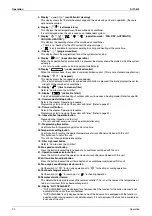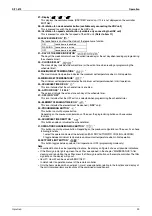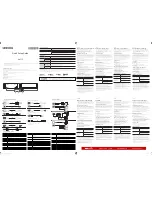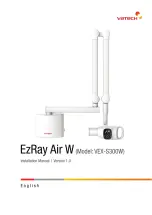
Si71-812
Product Specification
Product Specification
9
Note:
1. Cooling and heating capacities are based on the following conditions. Fan is based on High and Ultra-
high.
The figures in the parenthesis indicate the heat reclaimed from the heat recovery ventilator.
When calculating the capacity as indoor units, use the following figures : 3.5kW
2. Indoor temperature : 27°C DB, 19°C WB, Outdoor temperature : 35°C DB.
3. Indoor temperature : 20°C DB , Outdoor temperature : 7°C DB, 6°C WB.
4. The operating sound measured at the point 1.5m below the center of the unit is converted to that
measured at an anechoic chambar built in accordance with the JIS C 1502 condition. The actual
operating sound varies depending on the surrounding conditions (near running unit's sound, reflected
sound and so on) and is normally higher than this value.
For operation in a quiet room, it is required to take measures to lower the sound. In details, refer to
engineering data.
5. The noise level at the air discharge port is about 8-11 dB higher than the unit's operating sound.
For operation in a quiet room, it is required to take measures to lower the sound for example install more
than 2m soft duct near the air discharge grille.
6. Air flow rate can be changed over to Low mode or High mode.
7. Normal Amp., input, efficiency depend on the above air flow rate value.
8. OA : fresh air from outdoor, RA : return air from room
9. The specifications, designs and information here are subject to change without notice.
10.Temperature Exchange Efficiency is a mean value in cooling and heating.
11.Efficiency is measured under the following conditions. Ratio of rated external static pressure has been
kept as follows. Outdoor side to indoor side = 7 to 1
12.In heating operation, freezing of the outdoor unit's coil increases. Heating capability decreases and the
system goes into defrost operation.
During defrost operation, the fans of the unit continues driving (factory setting).
The purpose of this is to maintain the amount of ventilation and humidifying.
13.When connecting with a VRV Heat Recovery type outdoor unit and bringing the RA (exhaust gas intake)
of this unit directly in from the ceiling, connect to a BS unit identical to the VRV indoor unit (master unit),
and use group-linked operation. See the Engineering Data for details.
14.When connecting the indoor unit directly to the duct, always use the same system on the indoor unit as
with the outdoor unit, perform group-linked operation, and make the direct duct connection settings from
the remote controller.
(Mode No."17 (27)" -First code No."5" -Second code No."6")
Also, do not connect to the outlet side of the indoor unit. Depending on the fan strength and static
pressure, the unit might back up.
Summary of Contents for VKM100GAMV1
Page 9: ...Introduction Si71 812 viii ...
Page 43: ...Operation Si71 812 34 Operation ...
Page 53: ...Inspection and Maintenance of the Humidifier Si71 812 44 Maintenance ...
Page 91: ...Troubleshooting Si71 812 82 Troubleshooting ...
Page 99: ...Appendix Si71 812 90 Appendix 1 Appendix 1 1 Wiring Diagram VKM50GAMV1 VKM80GAMV1 VKM100GAMV1 ...
Page 100: ...Si71 812 Appendix Appendix 91 VKM50GAV1 VKM80GAV1 VKM100GAV1 ...
Page 103: ...Piping Diagram Si71 812 94 Appendix ...
Page 105: ...Si71 812 ii Index ...
















































